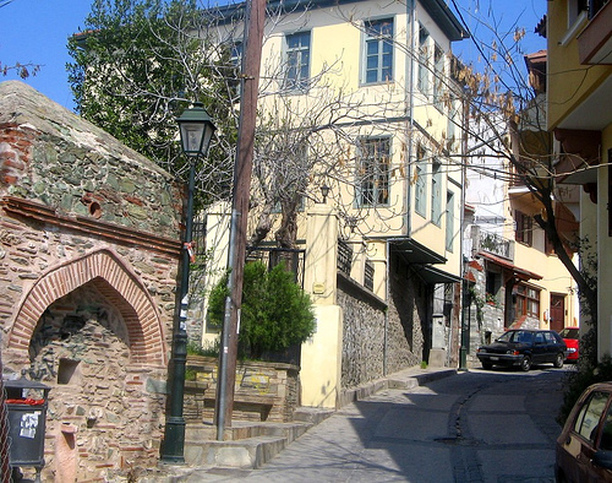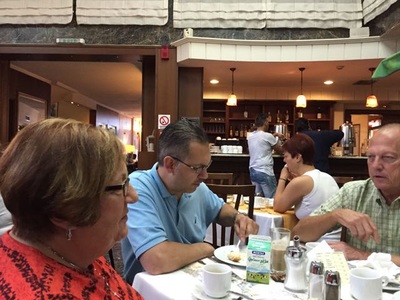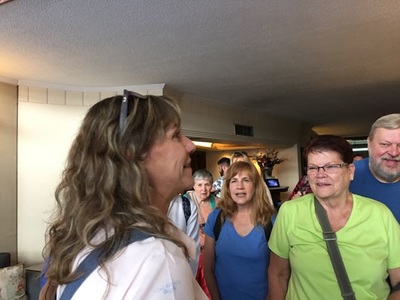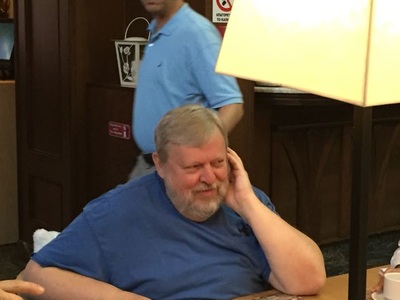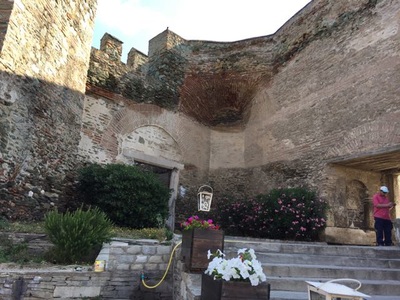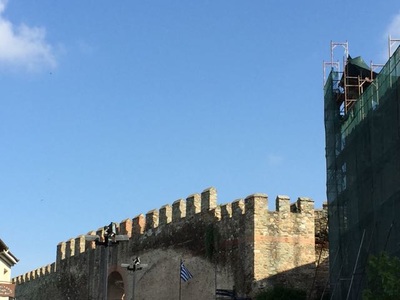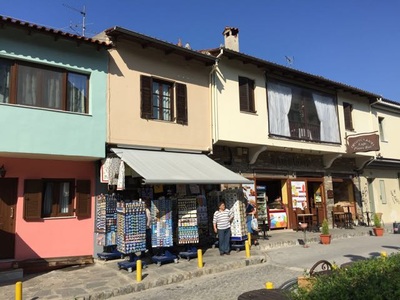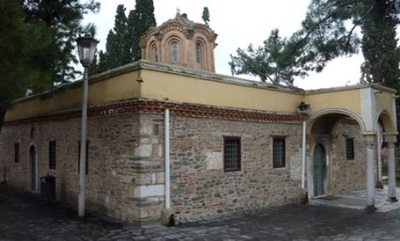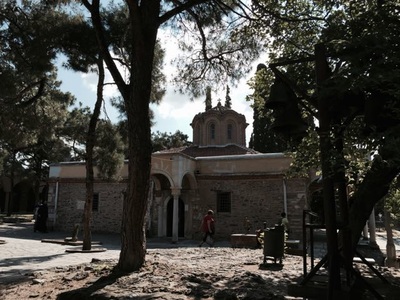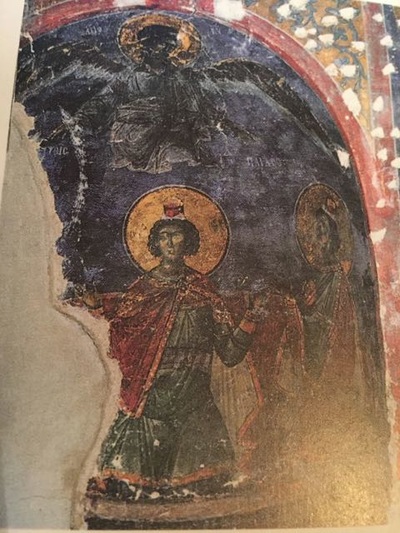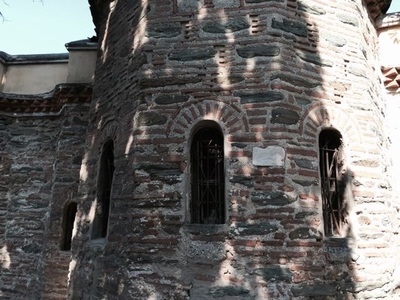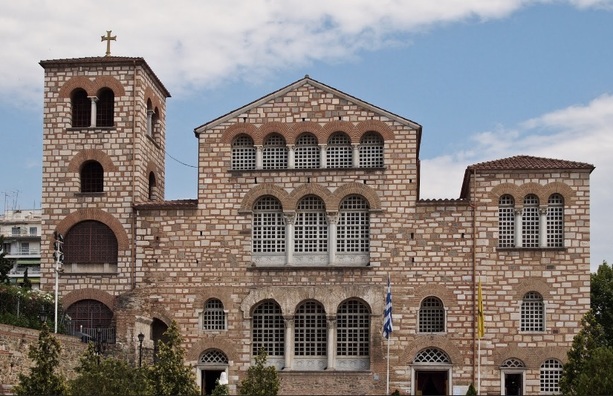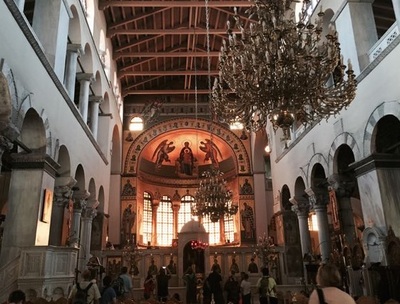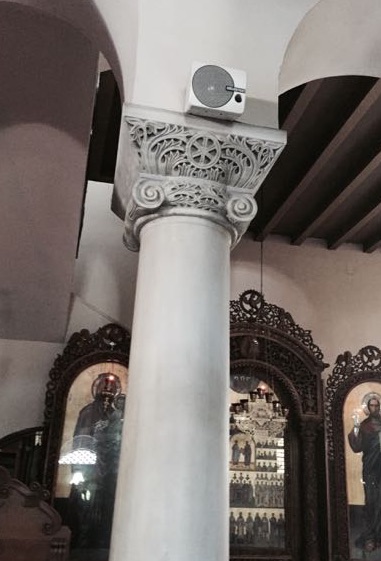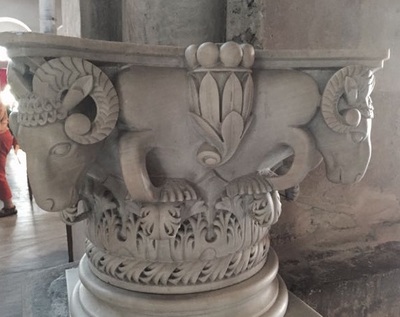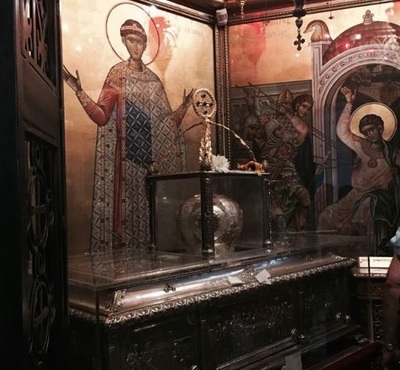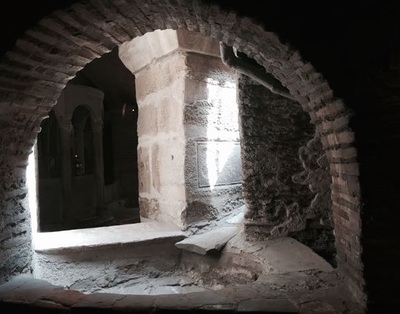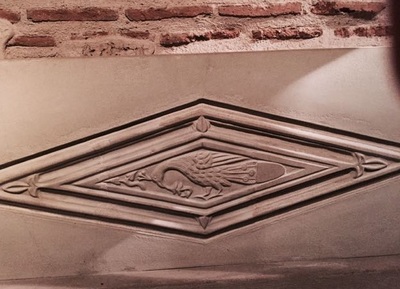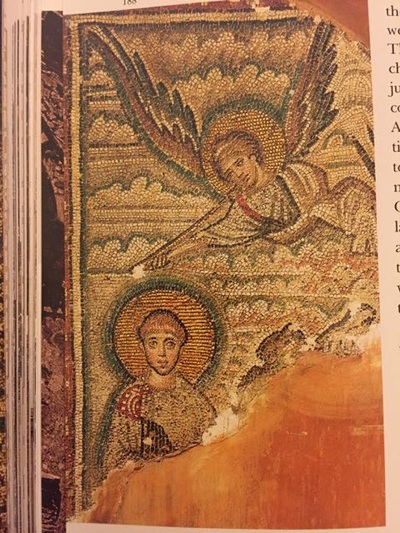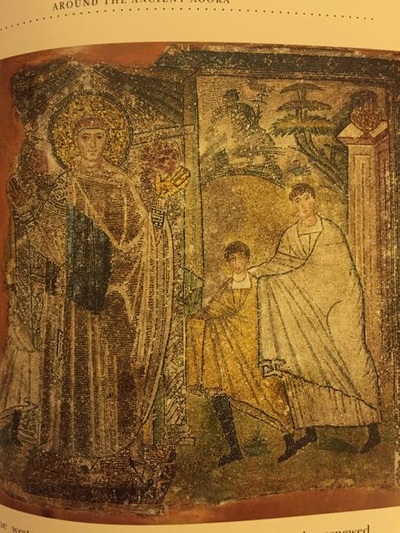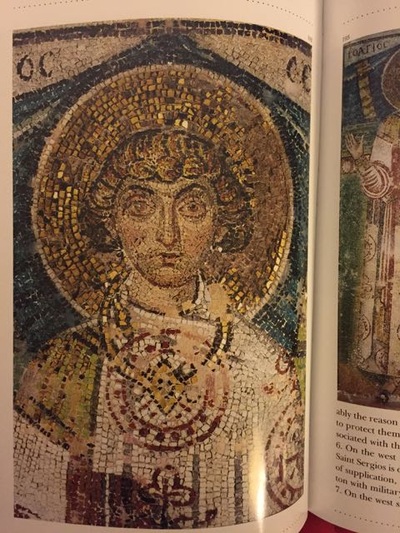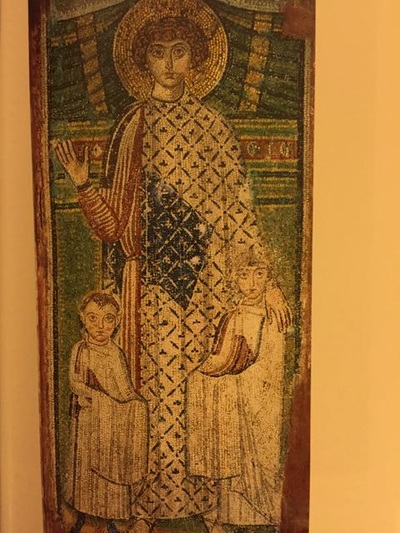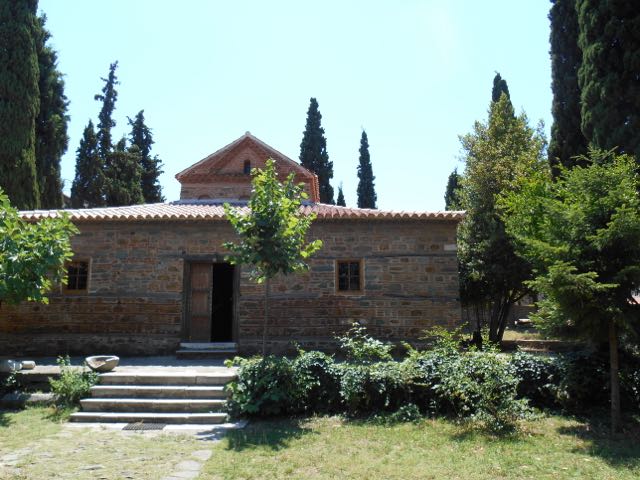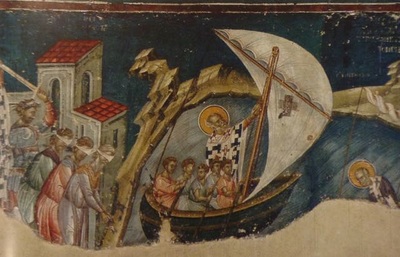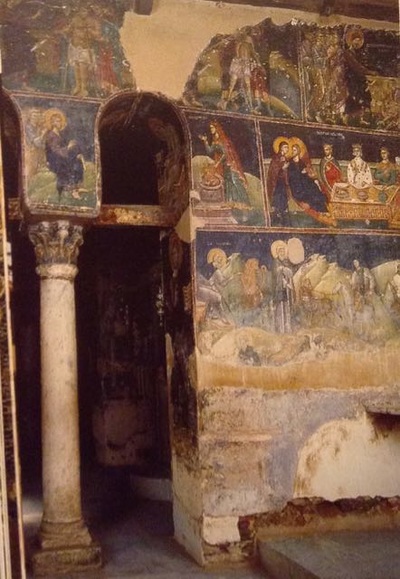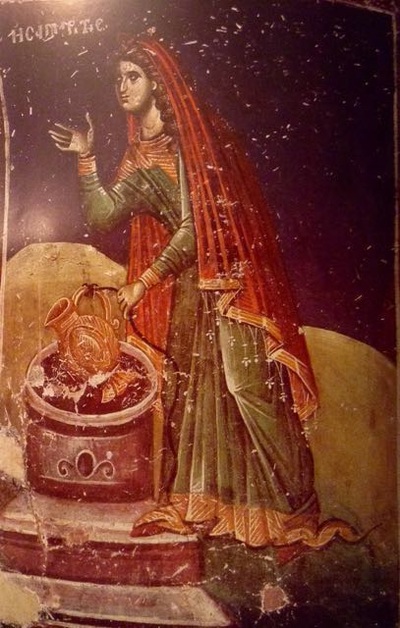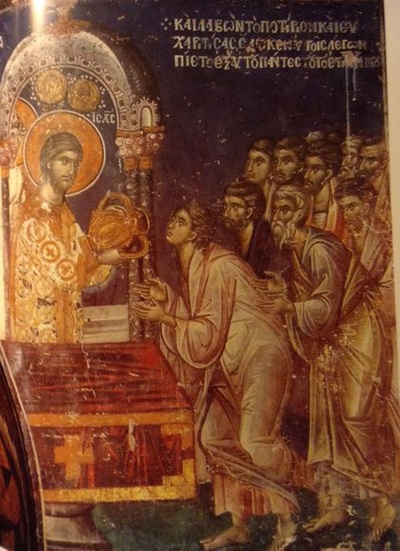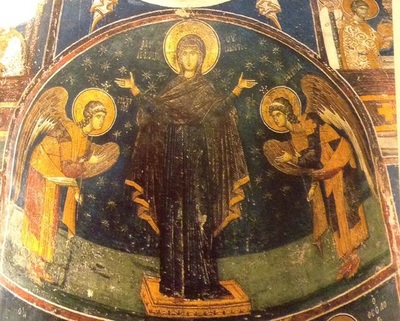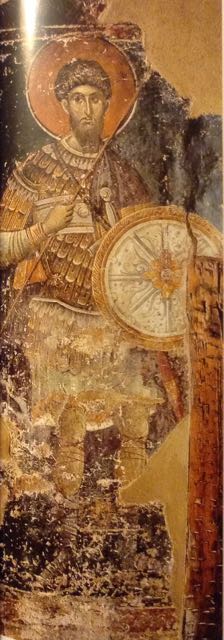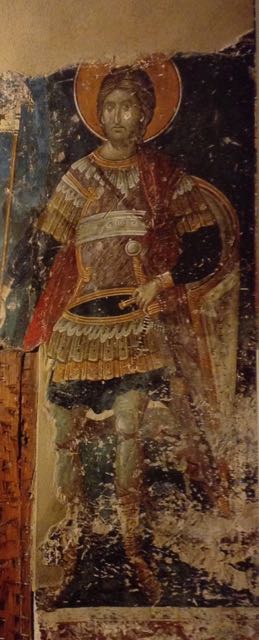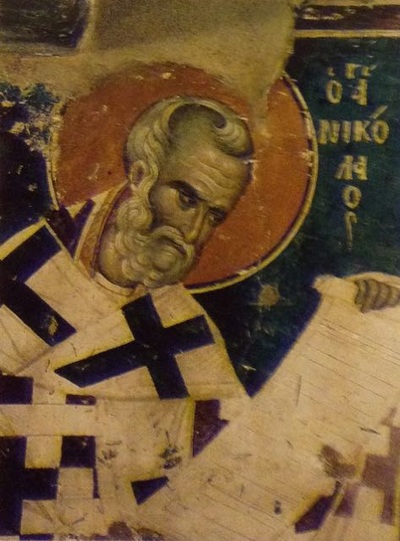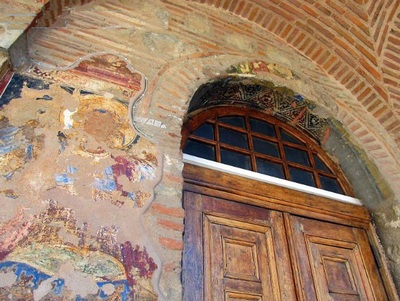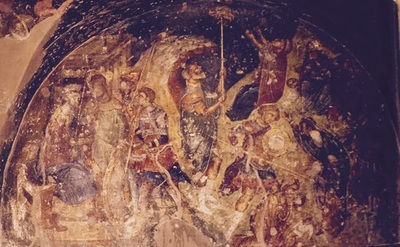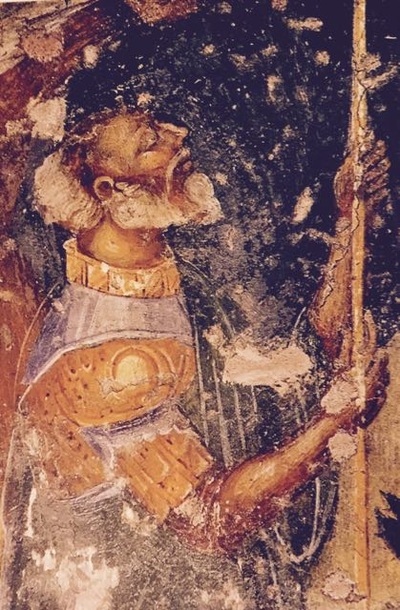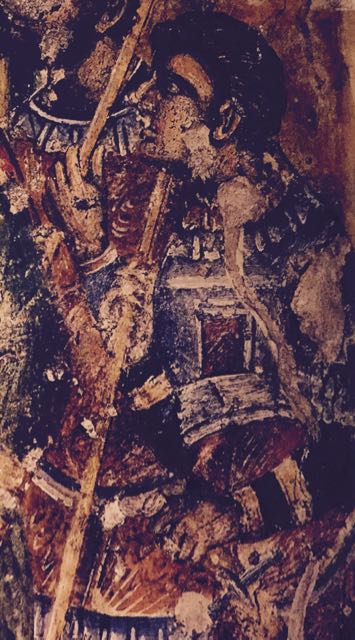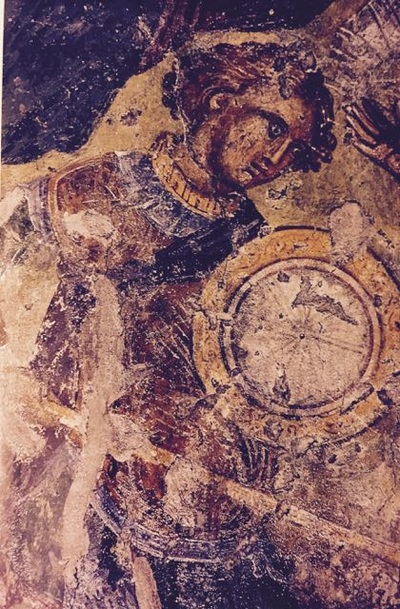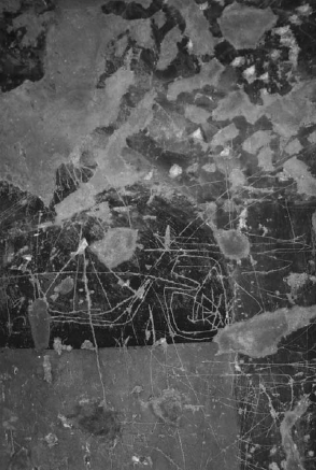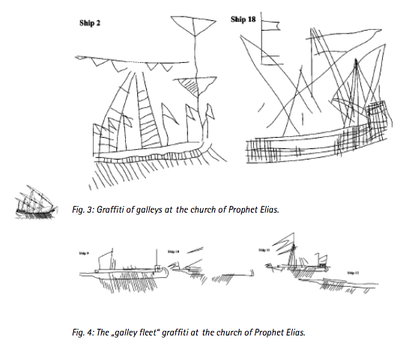Walking 7.9 Miles in Thessaloniki --- not for the faint of foot
|
We gathered as a group (16 people from Canada and the United States) for early breakfast and met our Guide, Fotini. She is president of Thessaloniki's Independent Guides and also volunteers for work against Human Trafficking. She knows every rock and church in Thessaloniki. We took a bus to the top of Ano Poli (Thessaloniki's Old City) and began a 7.9 mile hike down from the top. The old Roman era walls are still standing in this part of the city and and through the centuries have been renovated and restored. Like most ancient city with fortified walls, only the ones near the top of the city are still in tact, citizens of this part of Greece thinking that the historical "real estate" of the water below trumped saving the walls. When the Ottomans arrived they built their homes in Ano Poli, and many restored residences reflect the stunning architecture of the Turkish occupation as do more modern houses.
As we descended we visited churches, from 5th c. to 14th c. buildings. Many were destroyed by invading Ottomans and then the fire of 1917. The ones which were converted to mosques have beautiful frescoes and mosaics which were heavily damaged during the Ottoman era. The ones that didn't become mosques, like St. Nicholas Orphanon, have been preserved almost in their entirety. We saw many Byzantine churches as we walked the city but had time only for the ones described below. The city is infused with sudden glimpses of a Byzantine era church, building, bath or catacomb tucked between modern restaurants, stores, offices, residences and centers of learning. |
Please note: Visitors are not allowed in most churches and monasteries to take photographs inside the buildings. In order to share the interior beauty of these buildings photographs are from books I purchased on this journey. A list of references will appear at the end of the site. |
The Walls
At the top of the Ano Poli on the northeastern side of the eastern wall is the Tower of Trigonon, overlooking the Gulf of Salonica. The walls are aesthetic collections of stone, brick courses, arches, and architectural flourishes. Any material that was available was used in the 3 kilometers that are left of the original 7 kilometers of wall.
Churches
Vlatadon Monastery - Church of St. the Transfiguration
Lying just below the "Acropolis" of the Old City is the Monastery of Vlatadon, a 14h century and currently Patriarchal, working monastery. It is the leading monastery of Thessaloniki and serves also as a theological research facility for Mt. Athos, with its extensive libraries and manuscripts. It is said to have been the location of St. Paul's preaching to the Thessalonians and may have been built on the site of an earlier, 11th c. church. It is also said that St. Gregory Palamas spent time here as a monk. There is strong evidence that the hammer marks in the damaged frescoes were made during the Ottoman period in order to adhere plaster for covering the mosaics and frescos of Byzantine churches.
St. Demetrios Churchhis church dating from the 5th century, is one of the largest churches in Greece with the relics of St. Demetrios entombed in a side arch/niche. The church was built atop Roman public baths; during the Roman persecution of Christians under Diocletian, they also served as a prison; it was here that St. Demetrios was probably martyred. An earthquake destroyed the building in 620 but it was reconstructed similar to its original design. It has five aisles, no dome and four long double arched colonnades.
The colonnades divide the narthex into sections . The pillars are topped by diversely designed capitals. Examples of stone embellishments both here and in Thessaloniki’s Byzantine museum shows the artistic connection between Greek and Roman design principles as they were adopted and embellished by the Byzantines. The capitals and arches are intricately carved with eagles, rams and doves. The original wooden roof burned in the fire of 1917 and was rebuilt to withstand fire. The mosaics on the upper arches were also badly damaged in the fire, but a watercolor done before the fire shows the beauty of these mosaics. They portray St. Demetrios not as a soldier but as a young civil servant befriending angels and children. He is also depicted with the Roman patrons of the church. |
St. Demetrios, popular throughout the Orthodox world, is the patron saint of Thessaloniki. In iconography he is most often depicted as Roman soldier, but there are legends that he was t a Roman public civilian and his story may have been blended with the deacon/martyr Demetrios of Surmium.
The low-ceilinged catacombs/baths are infused with natural light, making it a quiet and peaceful place with beautiful stone carvings, patterned stone floors and decorated walls. Walking in the catacombs is almost peaceful though there is the "creep factor" in remembering its use as a torture chamber. |
The double colonnades divide the narthex into sections and whose pillars are topped by diversely designed capitals. What is striking is that both here and in Thessaloniki’s Byzantine museum one sees the artistic continuum between Greek and Roman design principles being adopted and embellished by the Byzantines. The capitals and arches are intricately carved with eagles, rams and doves. The original wooden roof burned in the fire of 1917 and was rebuilt to withstand fire. The mosaics on the upper arches were also badly damaged in the fire, but a watercolor done before the fire shows the original beauty of the mosaics.
The lower mosaics portray St. Demetrios not as a soldier but as a young civil servant befriending angels and children. He is also depicted with the Roman patrons of the church. On the eastern side across from the relics of St. Demetrios are is the Chapel of St. Euthymios were his relics are housed, and who also appears in beautifully preserved mosaic with a deacon. Other mosaics depict the Theotokos with St. Theodore, and there are wall paintings of the Communion of Apostles and other saints and feasts.
The lower mosaics portray St. Demetrios not as a soldier but as a young civil servant befriending angels and children. He is also depicted with the Roman patrons of the church. On the eastern side across from the relics of St. Demetrios are is the Chapel of St. Euthymios were his relics are housed, and who also appears in beautifully preserved mosaic with a deacon. Other mosaics depict the Theotokos with St. Theodore, and there are wall paintings of the Communion of Apostles and other saints and feasts.
St. Nicholas Orphanos
|
Half of the group needed to stop walking before we arrived at St. Nicholas Orphanos Church and they missed a feast. It was built in the early 14th c. though it’s not clear if the church was named for the family that found it or for St. Nicholas, who is known for his charitable work on behalf of children and orphans. Whatever its origins the church has been dedicated to St. Nicholas, one of Orthodoxy’s favorite saints.
Architecturally the exterior is not domed like many of the Byzantine churches but its charm is in its smallness the wall paintings from 1310-20. They have been remarkably preserved. Because the church did not become a mosque during the Ottoman period the frescos are intact, magnificent in their design and their use of color. The scenes from the life of St. Nicholas have been emulated by other iconographers. |
Church of the Prophet Elias
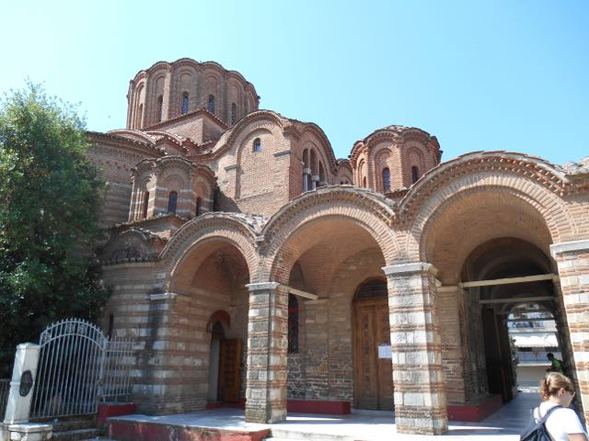
Many churches built on top of mountains in Greece honor the Prophet Elias because of his ascetic stay on Mt. Sinai. The exterior decoration of this church contains unusually beautiful ceramic. It was built around 1360, originally the Church of the Virgin under Turkish rule, when it became a mosque. The design is a domed cruciform with columns and short sections of wall. The church has three rounded apses.
The Church of the Prophet Elias was established in the 14th century by a famouns monk named Makarios Humnos and also by the monk Gabriel Some hstorians think this church served as the Katholikon of the Nea Moni. This has been disputed by scholars amd now many think that it was a rich monastic community associated with the Akapniou Monastery. Four small domed bays nestle against the sides of the large apses.
The building has rich brickwork alternating with stone layers that echos those in Constantinople. Its wall paintings were probably painted around 1360 and influenced many of the leading churches of Southern Serbia.
The paintings below, damaged badly over time are of "The Slaughter of the Innocents". An interesting feature of this church, since we saw so much wall graffiti in Thessaloniki, are the ancient scribed images of "ship graffiti" on top of the the frescos. One study goes into detail about these interesting but strange images: Byzantine ship graffiti from the church of Prophitis Elias in Thessaloniki by Andrea Babuin and Yannis Nakas (see last two images below).
The Church of the Prophet Elias was established in the 14th century by a famouns monk named Makarios Humnos and also by the monk Gabriel Some hstorians think this church served as the Katholikon of the Nea Moni. This has been disputed by scholars amd now many think that it was a rich monastic community associated with the Akapniou Monastery. Four small domed bays nestle against the sides of the large apses.
The building has rich brickwork alternating with stone layers that echos those in Constantinople. Its wall paintings were probably painted around 1360 and influenced many of the leading churches of Southern Serbia.
The paintings below, damaged badly over time are of "The Slaughter of the Innocents". An interesting feature of this church, since we saw so much wall graffiti in Thessaloniki, are the ancient scribed images of "ship graffiti" on top of the the frescos. One study goes into detail about these interesting but strange images: Byzantine ship graffiti from the church of Prophitis Elias in Thessaloniki by Andrea Babuin and Yannis Nakas (see last two images below).
